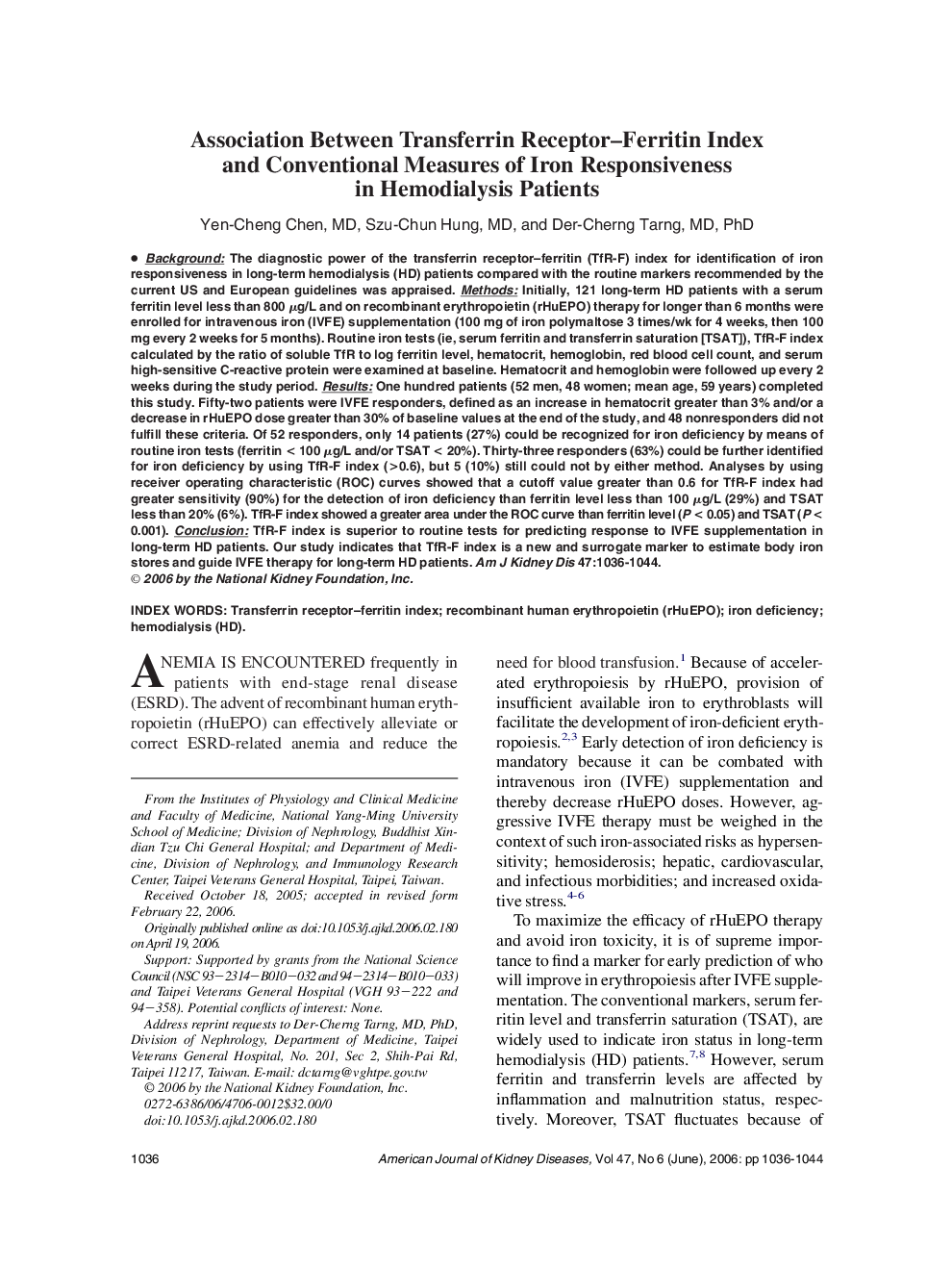| کد مقاله | کد نشریه | سال انتشار | مقاله انگلیسی | نسخه تمام متن |
|---|---|---|---|---|
| 3852167 | 1598387 | 2006 | 9 صفحه PDF | دانلود رایگان |
عنوان انگلیسی مقاله ISI
Association Between Transferrin Receptor-Ferritin Index and Conventional Measures of Iron Responsiveness in Hemodialysis Patients
دانلود مقاله + سفارش ترجمه
دانلود مقاله ISI انگلیسی
رایگان برای ایرانیان
کلمات کلیدی
موضوعات مرتبط
علوم پزشکی و سلامت
پزشکی و دندانپزشکی
بیماریهای کلیوی
پیش نمایش صفحه اول مقاله

چکیده انگلیسی
Background: The diagnostic power of the transferrin receptor-ferritin (TfR-F) index for identification of iron responsiveness in long-term hemodialysis (HD) patients compared with the routine markers recommended by the current US and European guidelines was appraised. Methods: Initially, 121 long-term HD patients with a serum ferritin level less than 800 μg/L and on recombinant erythropoietin (rHuEPO) therapy for longer than 6 months were enrolled for intravenous iron (IVFE) supplementation (100 mg of iron polymaltose 3 times/wk for 4 weeks, then 100 mg every 2 weeks for 5 months). Routine iron tests (ie, serum ferritin and transferrin saturation [TSAT]), TfR-F index calculated by the ratio of soluble TfR to log ferritin level, hematocrit, hemoglobin, red blood cell count, and serum high-sensitive C-reactive protein were examined at baseline. Hematocrit and hemoglobin were followed up every 2 weeks during the study period. Results: One hundred patients (52 men, 48 women; mean age, 59 years) completed this study. Fifty-two patients were IVFE responders, defined as an increase in hematocrit greater than 3% and/or a decrease in rHuEPO dose greater than 30% of baseline values at the end of the study, and 48 nonresponders did not fulfill these criteria. Of 52 responders, only 14 patients (27%) could be recognized for iron deficiency by means of routine iron tests (ferritin < 100 μg/L and/or TSAT < 20%). Thirty-three responders (63%) could be further identified for iron deficiency by using TfR-F index (>0.6), but 5 (10%) still could not by either method. Analyses by using receiver operating characteristic (ROC) curves showed that a cutoff value greater than 0.6 for TfR-F index had greater sensitivity (90%) for the detection of iron deficiency than ferritin level less than 100 μg/L (29%) and TSAT less than 20% (6%). TfR-F index showed a greater area under the ROC curve than ferritin level (P < 0.05) and TSAT (P < 0.001). Conclusion: TfR-F index is superior to routine tests for predicting response to IVFE supplementation in long-term HD patients. Our study indicates that TfR-F index is a new and surrogate marker to estimate body iron stores and guide IVFE therapy for long-term HD patients.
ناشر
Database: Elsevier - ScienceDirect (ساینس دایرکت)
Journal: American Journal of Kidney Diseases - Volume 47, Issue 6, June 2006, Pages 1036-1044
Journal: American Journal of Kidney Diseases - Volume 47, Issue 6, June 2006, Pages 1036-1044
نویسندگان
Yen-Cheng MD, Szu-Chun MD, Der-Cherng MD, PhD,